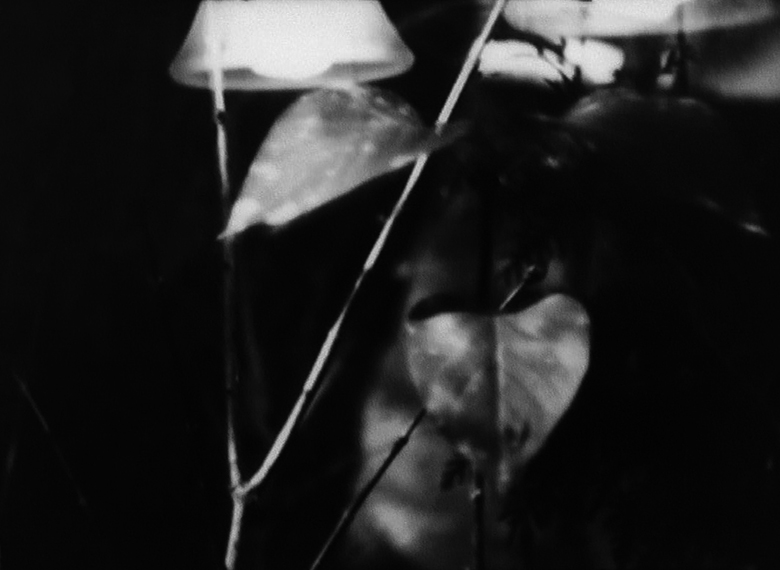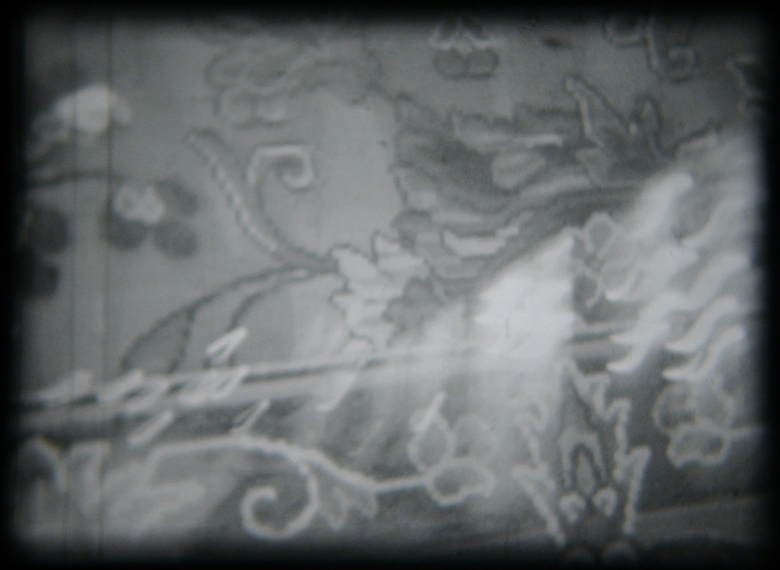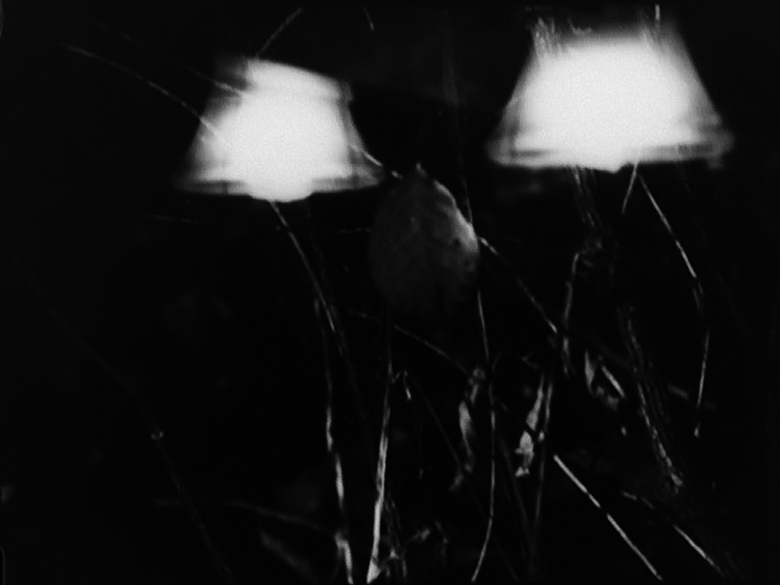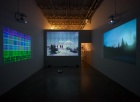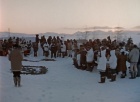Kyle Whitehead and Stephen Broomer are filmmakers—one in Calgary, the other in Toronto. From opposite sides of the country, the two have been making films out of a fascination for chance, each using double exposure as a means for accessing new knowledge, or revealing unexpected parallels in uncontrolled, chaotic dualities.
The Latent Collisions, initiated by Stephen Broomer, is a series of 16 mm films, 35 mm slides, and photographic prints produced by chance superimpositions, made either in collaboration with family, friends, and peers, or produced by Broomer alone. The blind second exposure is always committed without precise knowledge of the first; the latent image is elaborated and the project joins disparate visions, transforming an individual experience into something communal, plural, simultaneous. The Collisions are founded on the premise that images are enriched by polyphony and chance.
Interstices, initiated by Kyle Whitehead, is an ongoing series of collaborative, in-camera, double-exposure Super 8 films with the potential to continue indefinitely. In these process-based works, like Broomer’s, a second exposure is made by Whitehead's collaborators without prior knowledge of the preceding exposure. The resulting vignettes are aleatoric and non-linear amalgamations of two discrete perspectives. Unstable and intransitive by nature, these resonant and dissonant image-sentences continuously ebb and flow in and around each other, vying for presence on-screen and in the minds-eye.
This discussion, taking the form of a country-wide mirror reflecting Calgary on Toronto and vice versa, deconstructs the artists’ variant and paralleling practices, a culmination of over two years of ongoing exchange. “Double Visions” unpacks their processes—somewhat mutinous to hyper-control in technology relationships today—and invoking belief in a collective organization superior to cognitivism.
—Lindsay Sorell, Editor-in-Chief
SB: I became interested in superimposition soon after I began making films. I wasn’t drawn to it because it was a function of the camera; I wasn’t drawn to it because it is something our predecessors have done; I came to it by a very strong memory, a home movie, the only home movie I have of my mother as a little girl, receiving her first communion. She lifts a veil above her head and an airplane crosses her face, semi-transparent, and for an instant it seems as if her white veil is billowing by the wind shear of the plane. Her uncle, who had filmed the rite, accidentally filmed drill activities at an air base in a second exposure on top of the original image. And so her spiritual coming-of-age, in that ritual that makes children responsible for their own sins, had been occupied by the military in a very literal way.
Like many of the films that have impacted me most, this one was described to me years before I ever saw it. That image, of my mother as a child, is the seed of my interest in superimposition. It held the potential of crossing symbols and chance collision. When I began the Latent Collisions, it was the memory of this image that impressed upon me the absolute value of the subconscious juncture, as in the doubling of experiences, rubbing image upon image, voice upon voice.
KW: My motivation for starting Interstices was not that dissimilar from yours, although I don't have an anecdote as beautiful or poetic to share. As with you, I wasn't specifically motivated by any technical operation of the camera (although analogue film is an ideal medium for these types of blind cinematic collaborations), or even a fascination with superimposition; in fact, none of my previous films leverage superimposition in any way.
There is strange and complex synchronicity between all things—tapping into that system, and illuminating it is precisely what I'm interested in doing, to some degree, in all of my work.
What I was interested in rather was amalgamating discrete perspectives or experiences. The title of the series is a nod to the interstitial space that is created when two disparate visual perspectives collide, or co-habitate. I've always felt that once I express an idea out loud, or somehow verbalize a thought or concept, it becomes public domain. That is to say: anything I manifest outside of my own internal deliberations become a part of a collective consciousness. The ongoing experiment that is Interstices, is an attempt to prove a hypothesis that thoughts are not unique or singular, and it is my hope that by not revealing the content of my initial exposures, that perhaps my visual exploration as an action is enough to elicit a similar or complementary action on the part of my collaborators. To me, what is most interesting in these superimpositions is the spaces that are formed—the parallels or axioms that present themselves seemingly by chance.
SB: Your description makes me think of the notion of spooky action: action at a distance, the notion in physics that—if I may abuse it and bend it a bit—objects that are separated by space interact. Spooky action may sound mystical and romantic, even when supported by diligent scientific theories. But in this parallel, I’m speaking less about spooky action and more about ‘spooky’ inscription. I think of this because, though we’re often talking about collisions, the non-disclosure aspect that we share in has a kind of mystic faith, a faith that our undisclosed actions are influencing those of our collaborators. Palimpsest is always the first thing that I think of when I’m approaching my Collisions, or watching your Interstices, but this concept of spooky exchange would suggest to some the wildly unscientific notion of fated actions.
KW: There is definitely a fair amount of mysticism at work here. There are phenomena that science hasn't entirely unravelled, just can't explain. Spooky action is a nice analogy; if the phenomenon of particle entanglement is true at a molecular level, I don't think it's a stretch to assume it could be applied to larger bodies, or systems of particles separated over much larger distances, given the right circumstances. There is strange and complex synchronicity between all things—tapping into that system, and illuminating it is precisely what I'm interested in doing, to some degree, in all of my work.
SB: Have you found, in practice, that your films are pairing fully individuated perspectives? I ask this not as a charge, but because I’m actually concerned about this in my own rolls. My faith in the Latent Collisions is very much about the psychic potential of these unions, of mixing experience, but I’m always concerned about that aspect of the project. I want my project to reach that same wildness that I sense from what you’re describing as a collective unconscious, and yet, I worry about how much the parameters of my project encourage those collisions, and what unconscious influences I may be forcing onto my collaborators. Though I know that aleatoric gestures and chance aesthetics are commonly systematized, one has to be sincere and vigilant about one’s system.
For about two years, I’ve been shooting rolls collaboratively. I shoot an entire roll—of 35mm still film, or of 16mm movie film—and then I rewind it and give it to someone else to commit a second exposure, blind to the content of the first exposure. But such collaboration means being patient with others, and because my collaborators are often friends, many of them artists but often artists of other disciplines, I found myself giving them some basic training. There’s a pedagogical trap there, because if you’re showing someone how to use a camera, you might be guiding them also, by what you direct them to or by what of your work they already know. You may be training them to mirror the way your eye operates and to betray their own natural inclinations toward composition.
I decided that I would find a means to simultaneously do the work alone, and let my own subconscious network cross itself. I worked with only one type of film, shot four rolls once-through over the course of a month, rewound all of them and mixed them up, then set myself to filling in the second half of the image after enough time had lapsed that I could approach the reels fresh. Against union, this approach splinters the singular perspective so that it crosses over itself.
KW: I have found that some of the perspectives offered by my collaborators are in fact quite personal. The films, as a group, are an interesting mix. In most cases, the artists and filmmakers I've worked with have tended to approach their image-making in one of two ways; they shoot a personal place or story that is meant to be representative of them (and I use the term story loosely, as the films are strictly experimental works), or they choose a specific technical operation or action knowing the film is one long superimposition, approaching the film like a work of moving graphic art.
And, to respond to your other point, I have also questioned the extent to which I influence my collaborator’s contribution. We could deconstruct the nature of these “chance” collaborations to the point of no escape; we could reveal objectivity and sterility to be impossible. As you have pointed out, even a little knowledge or experience of my previous works could have an impact on what my collaborators choose to capture, resulting in emulation or appeasement, or in an attempt to frustrate any semblance of cohesiveness (although I haven’t yet worked with anyone being purposefully contrarian, that I am aware of). That being said, I don't know that I've ever been concerned about having a pedagogical influence on those I work with. Like you, I began working on Interstices committedly couple years ago, and since then I have exposed about 20 rolls of film in pursuit of this project. The process for Interstices has certainly been systematized, and they all follow a simple set of constant parameters.
All of the films are exposed in-camera on a single cartridge of Super 8 film, which is 50 feet long, or roughly three minutes and 20 seconds at 18 frames per second (I always project the films, on film, at this speed). The films are exposed twice—once by me, and once by my collaborator—each time assuming half the exposure index to assist the conflation of the images. Aside from this, I place no restrictions on my collaborators nor do I provide any instruction. In fact, many of the films have been made by correspondence, so there is often very little interaction between my collaborators and myself other than to coordinate logistics.
The problem inherent in cinema, or at least the problem I struggle with most, is that there is a tendency to premeditate reality before capturing it.
When starting the project, Super 8 seemed like an ideal format, as the film material is relatively inexpensive, almost expendable, and cameras are widely available and technically very simple to operate. Both Super 8 and 16mm films do not suffer from the registration issues I have experienced with 35mm film when making superimpositions, so I was confident at least one potential pitfall of double-exposing film would be a non-issue. Ultimately, I chose to work on Super 8 because I was confident most of my collaborators, even those that aren't filmmakers, could source equipment and get adequate images in most cases with little or no technical facility. Having said this, out of the 20 odd rolls I've exposed to-date, there are only seven I would consider worthy of exhibition. Surprisingly, when rolls don't turn out, it is almost always for technical reasons, so it is difficult to say with any certainly what proportion of the films may have failed aesthetically when the process simply didn’t work at all. There is no pre-supposed number of films, or planned end date for the series, so I don't fixate on these failures—I consider failure to be intrinsic to the project and to aleatoric practice generally. I embrace it.
SB: The embrace of failure here is a wonderful retort to the amount of planning and control, and most importantly, the inbuilt didacticism that artists summon up in making films. Part of what I love about these projects is that, though we’ve each developed systems, those systems are designed to surprise us, to give us unpredicted results. So whether that ends in technical failure or the gift of overlapping consciousness, at least it doesn’t begin with a mission statement, a thesis, a posture.
KW: Exactly right. The problem inherent in cinema, or at least the problem I struggle with most, is that there is a tendency to premeditate reality before capturing it. In my mind, this amounts to dodging the problem, but it is extremely challenging to get away from this mode of working when shooting images with a camera. The goal of these films is to capture images from reality and adopt a process that results in images, or compositions that are something more than sum of their parts.
SB: In my Latent Collisions, I’ve wanted there to be an erotic force to the images, and this is why I’m now working with the figure and the nude, and encouraging collaborators to turn the cameras on their intimate experiences. But you can’t force eros onto something, and I’ve often found these rolls to not only be unerotic, but kind of stale and rote. By being tasked with filling even a short roll with images, the parameters shield the work from the improvisation that is its goal, a sharp turn into the factory of forced imaginings. When I look at your Interstices, I don’t see that languidness that frustrates me in my own work, but I do sense a singularity of action, where two actions get laid on top of each other, and I wonder if this is something you’ve wrestled with as well. I had always expected the Latent Collisions to be a dialogue, marching forward ceaselessly, and I have been lucky at times, but have also found some of my rolls to be too insistent upon a singular act. This I’ve found to be true of those done both individually and in collaboration.
KW: I don't believe the films can be a singularity. In reality, the images did not exist simultaneously, but in practice, on the celluloid, they cannot exist separately either. The images serve to presuppose audience expectations and then frustrate them. There is a tension in the resulting films, a conflict, where each disparate perspective is vying for presence on-screen and in the minds-eye, and it is in this struggle that the true subject of the films can be found. For this reason, I'm very curious about the Latent Collisions you've been creating independently; I feel a certain ambivalence about this approach as an aleatoric process. Would you say that allowing some time to elapse before revisiting the material gives you a level of neutrality or detachment from the images? Do you have a system for these sorts of collaborations with the self? Can these ever be blind or aleatoric to the same extent as the alternative?
SB: Well, when I say singularity here, I don’t mean that the two actions join into a singular perspective, which is nowhere near my intention. Rather I mean that in their separate ways, each exposure may be too insistent on exploring, say, one minimalistic composition or series of compositions, as opposed to exploring a wide range of perceptual experiences. These kinds of collisions are fine in still images, but they don’t work at all for the 16mm films. This is something I’ve worked hard to challenge, and films that don’t meet my expectations in the way that I’ve described are left unfinished.
In terms of the self-collaborations, which comprise a very small section of the Latent Collisions, of course they’re aleatoric, much in the same way that the central body of the work is. I approach rolls as streams of perceptual experience, and rarely remember what I’ve shot on any camera roll, not only those in the Latent Collisions, until I see the image projected. This approach, magnified by the distance of time, and the mixing up of my rolls so that they bear no identification before the second pass, situates this process very clearly in modernist chance aesthetics. Even issuing from a single voice—even if I gave myself knowledge, some kind of script, of what I had shot the first pass through—the Collisions themselves would be indeterminate by the nature of operator rhythms, which in my view don’t only change from operator to operator, but from act to act.
KW: Maybe a good strategy for self-collaboration would be to shoot films while consuming enough alcohol to induce anterograde amnesia. Of course I am joking but it would provide, quite literally, a blank perspective when shooting a second exposure. Approaching the images as stream of consciousness is likely a good strategy. I've found the hard cuts—or any other abrupt transition—can be extremely jarring when watching two sequences simultaneously, and I've taken to using long dissolves between sequences, or simply making exposures that are a single takes without cuts, leveraging camera movement to make the scene dynamic, in an effort to make the layering of images and the temporal progression of the films as seamless as possible.
I understand what you are saying in regards to the operator as variable. Given the same set of parameters and tools, no two filmmakers would ever create identical films; there is always the variable of the moment, the fleeting instance or fraction of time, arrested on film never to be seen or duplicated by another again. For all of our best intentions, it is impossible to know what has actually been captured with any certainty. The only certainty is the act.

